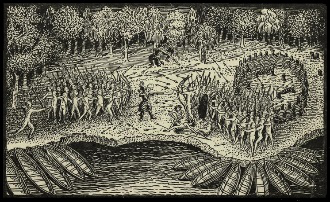CHAMPLAIN, HURON & ALGONQUINS DEFEAT IROQUOIS USING FIREARMS NEAR TICONDEROGA

In the summer of 1609, the Wendat (called “Huron” by the French), the Algonquin, and other tribes that lived near the St. Lawrence River demanded that Samuel de Champlain help them against the Iroquois. Champlain set off with 9 French soldiers and 300 natives to explore the Rivière des Iroquois (now the Richelieu River). He also mapped what is now Lake Champlain. Having had no encounters, many of his force headed back, leaving him with 2 Frenchmen and 60 natives. On July 29, on the western shore of the lake and likely near the site that would become Fort Ticonderoga, Champlain’s party encountered a group of 200+ Iroquois. The next day, the Iroquois advanced on his position. One of his guides pointed out the 3 Iroquois chiefs. Champlain fired his arquebus, killing 2 with a single shot. One of his men killed the third. At this, the Iroquois fled. This likely was their first encounter with Europeans and their firearms. It also marked the start of the Beaver Wars (1690-1701) & Iroquois alliance with the British.
Sources:
“Battle of Lake Champlain, Summary, Facts, Significance, 1609,” American History Central. Retrieved 10/9/2023, Battle of Lake Champlain, Summary, Facts, Significance, 1609 (americanhistorycentral.com)
Wikipedia
Engraving: Engraver unknown, 1609. This is an engraving based on a drawing by Samuel de Champlain of his 1609 voyage. It depicts the July 30th battle between Iroquois and Algonquian tribes near the southern end of Lake Champlain, possibly near the site where Fort Ticonderoga now stands. Public Domain. Source: The engraving was published on p. 8 of Francis Parkman's Historic handbook of the northern tour. Lakes George and Champlain; Niagara; Montreal; Quebec. (1885).
